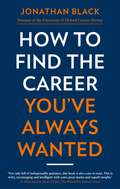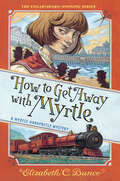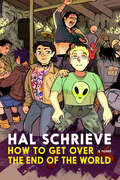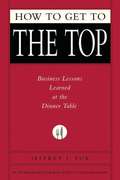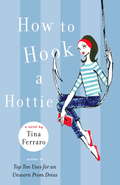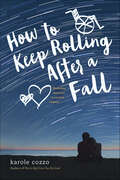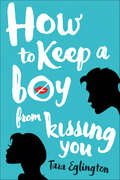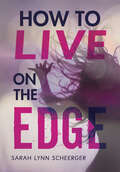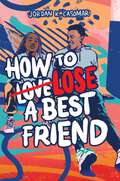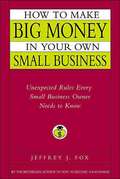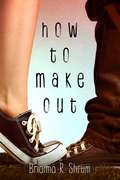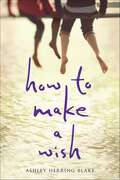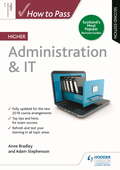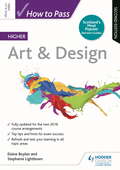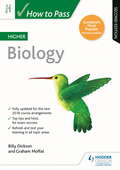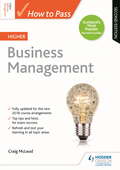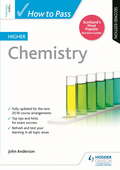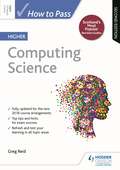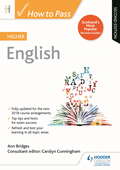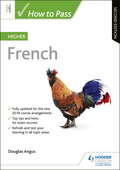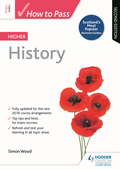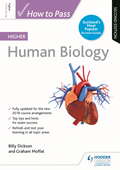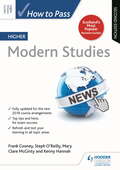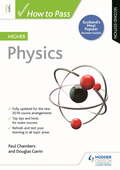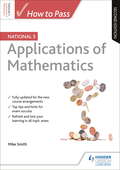- Table View
- List View
How to Find the Career You've Always Wanted: How to take control of your career plan and make it happen
by Jonathan BlackFrom the Financial Times careers adviser, this book of wisdom will help you feel more empowered about your career. You can read it from beginning to end, or dive into specific sections for immediate advice on, for example, writing your CV. 'We will certainly be recommending the book to all our parents. It's quite simply the best available' - George Fussey, Head of Career Education, Eton College'One of the most practical and comprehensible career guides ever produced' - Baroness Gillian ShephardHow to Find the Career You've Always Wanted is made up of three sections:Stepping Back - What's this all about? The bigger issues that frame the whole area of your career and jobs; looking down on your career map from 10,000 feet. Practicalities - What do I do on Monday morning? CVs, applications, interviews and all the other details on your map. Along the Way - Or, how do I keep going? How to cope with the hurdles and challenges that you might encounter while you're travelling along your route It includes an extensive set of real examples to bring it all alive, and is grounded with helpful statistics and sociological research.Jonathan Black is Director of the Careers Service at the University of Oxford. He himself has had many different jobs, including: management consultant, professional publisher, co-found of a start-up company, finance director, aerospace engineer, computer salesman and strategy direct. In this book, he dispenses wisdom accrued in the course of a long and varied career, in which he has helped many thousands find the career of their dreams.'Indispensable, inviting and engaging' - Prof Dame Carol Black, DBE, FRCP, FMedSci'A book about how to lead a happy life' - James Hodgson, Bedford School'A uniquely powerful guidebook' - Mark Byford, Egon Zehnder'The definitive careers guide' - David Palfreyman, OBE'Wise, calming and pragmatic' - Emma Jacobs, FT'A true career design compendium' - Caroline Konrad, Ryerson University'Winningly combines anecdotes, surveys and years of professional experience' - Dr Tim Hands, Winchester School'Elegant, light and humorous style' - Prof Dame Carol Black, DBE, FRCP, FMedSci'From an expert at the top of his game' - David Palfreyman, OBE
How to Get Away with Myrtle (Myrtle Hardcastle Mystery)
by Elizabeth C. BunceBefore the train has left the station, England’s most accomplished new detective already is on a suspect’s trail, and readers will be delighted to travel along. Myrtle Hardcastle has no desire to go on a relaxing travel excursion with her aunt Helena when there are More Important things to be done at home, like keeping close tabs on criminals and murder trials. Unfortunately, she has no say in the matter. So off Myrtle goes—with her governess, Miss Judson, and cat, Peony, in tow—on a fabulous private railway coach headed for the English seaside. Myrtle is thrilled to make the acquaintance of Mrs. Bloom, a professional insurance investigator aboard to protect the priceless Northern Lights tiara. But before the train reaches its destination, both the tiara and Mrs. Bloom vanish. When Myrtle arrives, she and Peony discover a dead body in the baggage car. Someone has been murdered—with Aunt Helena’s sewing shears. The trip is derailed, the local police are inept, and Scotland Yard is in no rush to arrive. What’s a smart, bored Young Lady of Quality stranded in a washed-up carnival town to do but follow the evidence to find out which of her fellow travelers is a thief and a murderer?
How to Get over the End of the World: A Novel
by Hal SchrieveBoldly weird, cool, and confident, this YA novel of LGBTQ+ teen artists, activists, and telepathic visionaries offers hope against climate and community destruction. From the National Book Award–longlisted author of Out of Salem.James Goldberg, self-described neurotic goth gay transsexual stoner, is a senior in high school, and fully over it. He mostly ignores his classes at Cow Pie High, instead focusing on fundraising for the near-bankrupt local LGBTQ+ youth support group, Compton House, and attending punk shows with his friend-crush Ian and best friend Opal. But when James falls in love with Orsino, a homeschooled trans boy with telepathic powers and visions of the future, he wonders if the scope of what he believes possible is too small. Orsino, meanwhile, hopes that in James he has finally found someone who will be able to share the apocalyptic visions he has had to keep to himself, and better understand the powers they hold.How to Get over the End of the World confirms Hal Schrieve as a unique and to-be-celebrated voice in LGBTQ+ YA fiction with this multi-voiced story about flawed people trying their hardest to make a better world, about the beauty and craziness of hope, about too-big dreams and reality checks, and about the ways in which human messiness—egos, jealousy, insecurity—and good faith can coexist. It also about preserving the ties within a chosen family—and maybe saving the world—through love, art, and acts of resistance.
How to Get to the Top: Business Lessons Learned at the Dinner Table
by Jeffrey J. FoxThe bestselling author of How to Become CEO returns with a pithy, smart, and useful collection of wisdom learned by business leaders at their own family dinners.Do you want to get to the top? Do you want to know how to rise above the crowd and become a leader in your field? Then this is the book for you. In How to Get to the Top, bestselling author Jeffrey J. Fox combines his own experience as an extremely successful entrepreneur with lessons learned at the family dinner table by business leaders such as Howard Schultz, CEO of Starbucks; Tom Chappell, founder of Tom's of Maine; Leslie Blodgett, CEO of Bare Escentuals; and George Steinbrenner, principal owner of the New York Yankees. The essential guide on how to get to the top--and stay there--this compelling book contains hard-hitting advice on independence and self-reliance, management dynamics, and problem solving, including: You can't unsour the milk. Speak sweetly: You may have to eat your words. Tip as if you were the tippee. Act like you own the place. You have to know the rules to break them. Never be late. Always compliment the chef . . . especially at home. Teach your girls to whistle. Spend the company's money as you would your own. Don't teach the quarterback to catch.
How to Hook a Hottie
by Tina FerraroAt 17, Kate Delvecchio has one goal in life: to become a millionaire before the age of 20. And as far as she's concerned, college will only slow her down. Unfortunately for Kate, the one thing her parents do agree on is that they totally disagree with her strategy. And so the deal is born. If Kate can raise five thousand big ones by graduation day, her parents will hand over the balance of her college account to invest as she pleases. No college, no degree, and no way she'll ever be able to pull it off. But when Kate accidentally agrees to go to the sports banquet with the hottest guy at school, she stumbles upon a possible cash cow. The rest of the junior class is amazed that no-nonsense Kate could hook such a hottie, and one by one they approach her for help hooking their own. She doesn't know anything about getting guys, but for $100 a pop, she's more than willing to invent a six-step plan for How to Hook a Hottie. And how could that possibly backfire?
How to Keep Rolling After a Fall
by Karole CozzoThe party was at her house. The photos were posted to her Facebook account. That's all the evidence anyone needed to condemn Nikki Baylor for a cyberbullying incident that humiliated a classmate and nearly resulted in the girl's suicide. Now Nikki's been expelled from her old school, her friends have abandoned her, and even her own parents can't look her in the eye. With her plans for the future all but destroyed, Nikki resigns herself to being the girl everyone hates - almost as much as she hates herself. But then Nikki meets Pax, a spirited wheelchair rugby player who knows what it's like when one mistake completely shatters your life. Refusing to judge her because of her past, he shows her that everyone deserves a second chance... and everyone deserves to be loved.
How to Keep a Boy from Kissing You (Aurora Skye)
by Tara EglingtonSweet sixteen and never been kissed . . .That’s Aurora Skye’s big secret. And the way she wants it to stay. She’s not going to give away her first kiss to just anyone. Busy dodging suitors and matchmaking for her best friends, Aurora (not so) patiently awaits her prince.But everything changes when Aurora is coerced into a lead role in the school production of Much Ado about Nothing. Which means she’ll have to lock lips with her co-star Hayden Paris—the smart and funny boy next door who also happens to be the bane of her existence, always around to see her at her worst.Now Aurora is more determined than ever to have her first kiss with the one who’s truly worthy of it. But first she’ll have to figure out just who that person is.Romantic and funny, Tara Eglington's How to Keep a Boy from Kissing You is a feel-good tale of finding love where you least expect it.
How to Live on the Edge
by Sarah Lynn ScheergerEighteen-year-old Cayenne barely remembers her mother, who died of breast cancer when Cayenne was four. The women in her family have a history of dying young. Cayenne figures she'll meet the same fate, so she might as well enjoy life now, engaging in death-defying risks like dodging trains and jumping off cliffs with her boyfriend. When Cayenne receives a series of video messages her mother made for her before dying, she isn't sure she wants them. Her aunt Tee has been her true mother figure. But then Aunt Tee tests positive for a BRCA gene mutation—the one that doomed Cayenne's mom—and decides to get a mastectomy to reduce her chances of developing cancer. As Cayenne helps her aunt prepare for the surgery, she finds herself drawn to her mother's messages, with their musings on life, love, and perseverance. For the first time, Cayenne starts to question what it truly means to live life to the fullest, even when death might be written into her DNA.
How to Lose a Best Friend
by Jordan K. CasomarThis &“important and necessary book for our time&” (Amber Smith, New York Times bestselling author of The Way I Used to Be) confronts the myth of the friendzone as a boy in love with his best friend feels he&’s owed a chance at romance—and she&’s the only one in their lives who disagrees.For as long as anyone can remember, Zeke Ladoja and Imogen Parker have been best friends. Their classmates, their parents, and even the school custodian think that they&’re meant to be together. And that&’s exactly what Zeke wants: for Gen to be his girlfriend. Now that she&’s about to be sixteen (and allowed to date), Zeke is finally going to tell her how he feels—in front of everyone at her birthday party. Imogen loves Zeke with all her heart, but only as a friend. The pressure to be with Zeke has sometimes been overwhelming, but up to this point, she&’s been able to manage it. Then she falls for the new boy, Trevor Cook, and she knows the news will devastate Zeke. The last thing she wants to do is hurt her best friend, but she also resents the fact that no one seems to care about what she wants. The night of Gen&’s party, everything goes wrong. There&’s backlash, most of it directed at Gen, and Zeke feels emboldened. He isn&’t about to give up on his feelings, and he&’ll do whatever it takes to prove that she made the wrong choice…even if it means destroying their friendship. But Gen isn&’t about to give up on fighting for herself and the freedom to love the boy she wants, not the boy she&’s expected to be with.
How to Make Big Money in Your Own Small Business: Unexpected Rules Every Small Business Owner Needs to Know
by Jeffrey J. FoxEver dream of starting your own business? According to USA Today, more than 47 million people want to own their own businesses and over 20 million actually do. In How to Make Big Money in Your Own Small Business, bestselling business author Jeffrey Fox offers sound rules to succeeding in small business, whether you're running a bookstore, consulting business, or restaurant. In short chapters that range from administration and cash flow to marketing and hiring, Fox reminds entrepreneurs what's important and what's not, what makes a business succeed, and what causes it to fail.
How to Make Out
by Brianna ShrumSixteen-year-old Renley needs three thousand dollars for the math club’s trip to New York City, and she knows exactly how to get it: she’s going to start a how-to blog where people pay for answers to all of life’s questions from a "certified expert.” The only problems: 1) She doesn’t know how to do anything but long division and calculus. 2) She’s totally invisible to people at school. And not in a cool Gossip Girl kind of way.So, she decides to learn to do . . . well . . . everything. When her anonymous blog shifts in a more scandalous direction and the questions (and money) start rolling in, she has to learn not just how to do waterfall braids and cat-eye makeup, but a few other things, like how to cure a hangover, how to flirt, and how to make out (something her very experienced, and very in-love-with-her neighbor, Drew, is more than willing to help with).As her blog’s reputation skyrockets, so does "new and improved” Renley’s popularity. She’s not only nabbed the attention of the entire school, but also the eye of Seth Levine, the hot culinary wizard she’s admired from across the home-ec classroom all year.Soon, caught up in the thrill of popularity both in and out of cyberspace, her secrets start to spiral, and she finds that she’s forgotten the most important how-to: how to be herself. When her online and real lives converge, Renley will have to make a choice: lose everything she loves in her new life, or everyone she loves in the life she left behind.
How to Make a Wish
by Ashley Herring BlakeGrace, tough and wise, has nearly given up on wishes, thanks to a childhood spent with her unpredictable, larger-than-life mother. But this summer, Grace meets Eva, a girl who believes in dreams, despite her own difficult circumstances. One fateful evening, Eva climbs through a window in Grace&’s room, setting off a chain of stolen nights on the beach. When Eva tells Grace that she likes girls, Grace&’s world opens up and she begins to believe in happiness again. How to Make a Wish is an emotionally charged portrait of a mother and daughter&’s relationship and a heartfelt story about two girls who find each other at the exact right time.
How to Pass Higher Administration & IT: Second Edition Epub
by Adam Stephenson Anne BradleyExam Board: SQA Level: Higher Subject: Administration & IT First Teaching: August 2018 First Exam: May 2019Get your best grade with comprehensive course notes and advice from Scotland's top experts, fully updated for the latest changes to SQA Higher assessment. How to Pass Higher Administration & IT Second Edition contains all the advice and support you need to revise successfully for your Higher exam. It combines an overview of the course syllabus with advice from top experts on how to improve exam performance, so you have the best chance of success.- Revise confidently with up-to-date guidance tailored to the latest SQA assessment changes - Refresh your knowledge with comprehensive, tailored subject notes- Prepare for the exam with top tips and hints on revision techniques- Get your best grade with advice on how to gain those vital extra marks
How to Pass Higher Art & Design: Second Edition Epub
by Elaine Boylan Stephanie LightbownExam Board: SQA Level: Higher Subject: Art & Design First Teaching: August 2018 First Exam: May 2019Get your best grade with comprehensive course notes and advice from Scotland's top experts, fully updated for the latest changes to SQA Higher assessment. How to Pass Higher Art & Design Second Edition contains all the advice and support you need to revise successfully for your Higher exam. It combines an overview of the course syllabus with advice from top experts on how to improve exam performance, so you have the best chance of success.- Revise confidently with up-to-date guidance tailored to the latest SQA assessment changes - Refresh your knowledge with comprehensive, tailored subject notes- Prepare for the exam with top tips and hints on revision techniques- Get your best grade with advice on how to gain those vital extra marks
How to Pass Higher Biology: Second Edition Epub (How To Pass - Higher Level Ser.)
by Graham Moffat Billy DicksonExam Board: SQA Level: Higher Subject: Biology First Teaching: August 2018 First Exam: May 2019Get your best grade with comprehensive course notes and advice from Scotland's top experts, fully updated for the latest changes to SQA Higher assessment.How to Pass Higher Biology Second Edition contains all the advice and support you need to revise successfully for your Higher exam. It combines an overview of the course syllabus with advice from top experts on how to improve exam performance, so you have the best chance of success.- Revise confidently with up-to-date guidance tailored to the latest SQA assessment changes - Refresh your knowledge with comprehensive, tailored subject notes- Prepare for the exam with top tips and hints on revision techniques- Get your best grade with advice on how to gain those vital extra marks
How to Pass Higher Business Management: Second Edition Epub
by Craig McLeodExam Board: SQA Level: Higher Subject: Business Management First Teaching: August 2018 First Exam: May 2019Get your best grade with comprehensive course notes and advice from Scotland's top experts, fully updated for the latest changes to SQA Higher assessment. How to Pass Higher Business Management Second Edition contains all the advice and support you need to revise successfully for your Higher exam. It combines an overview of the course syllabus with advice from a top expert on how to improve exam performance, so you have the best chance of success.- Revise confidently with up-to-date guidance tailored to the latest SQA assessment changes - Refresh your knowledge with comprehensive, tailored subject notes- Prepare for the exam with top tips and hints on revision techniques- Get your best grade with advice on how to gain those vital extra marks
How to Pass Higher Chemistry: Second Edition Epub
by John AndersonExam Board: SQA Level: Higher Subject: Chemistry First Teaching: August 2018 First Exam: May 2019Get your best grade with comprehensive course notes and advice from Scotland's top experts, fully updated for the latest changes to SQA Higher assessment.How to Pass Higher Chemistry Second Edition contains all the advice and support you need to revise successfully for your Higher exam. It combines an overview of the course syllabus with advice from a top expert on how to improve exam performance, so you have the best chance of success.- Revise confidently with up-to-date guidance tailored to the latest SQA assessment changes - Refresh your knowledge with comprehensive, tailored subject notes- Prepare for the exam with top tips and hints on revision techniques- Get your best grade with advice on how to gain those vital extra marks
How to Pass Higher Computing Science: Second Edition Epub (How To Pass - Higher Level Ser.)
by Greg ReidExam Board: SQA Level: Higher Subject: Computing Science First Teaching: August 2018 First Exam: May 2019 Get your best grade with comprehensive course notes and advice from Scotland's top experts, fully updated for the latest changes to SQA Higher assessment. How to Pass Higher Computing Science Second Edition contains all the advice and support you need to revise successfully for your Higher exam. It combines an overview of the course syllabus with advice from a top expert on how to improve exam performance, so you have the best chance of success.- Revise confidently with up-to-date guidance tailored to the latest SQA assessment changes - Refresh your knowledge with comprehensive, tailored subject notes- Prepare for the exam with top tips and hints on revision techniques- Get your best grade with advice on how to gain those vital extra marks
How to Pass Higher English: Second Edition Epub
by Ann BridgesExam Board: SQA Level: Higher Subject: English First Teaching: August 2018 First Exam: May 2019Get your best grade with comprehensive course notes and advice from Scotland's top experts, fully updated for the latest changes to SQA Higher assessment. How to Pass Higher English Second Edition contains all the advice and support you need to revise successfully for your Higher exam. It combines an overview of the course syllabus with advice from a top expert on how to improve exam performance, so you have the best chance of success.- Revise confidently with up-to-date guidance tailored to the latest SQA assessment changes - Refresh your knowledge with comprehensive, tailored subject notes- Prepare for the exam with top tips and hints on revision techniques- Get your best grade with advice on how to gain those vital extra marks
How to Pass Higher French: Second Edition Epub
by Douglas AngusExam Board: SQA Level: Higher Subject: French First Teaching: August 2018 First Exam: May 2019Get your best grade with comprehensive course notes and advice from Scotland's top experts, fully updated for the latest changes to SQA Higher assessment. How to Pass Higher French Second Edition contains all the advice and support you need to revise successfully for your Higher exam. It combines an overview of the course syllabus with advice from a top expert on how to improve exam performance, so you have the best chance of success.- Revise confidently with up-to-date guidance tailored to the latest SQA assessment changes - Refresh your knowledge with comprehensive, tailored subject notes- Prepare for the exam with top tips and hints on revision techniques- Get your best grade with advice on how to gain those vital extra marks
How to Pass Higher History: Second Edition Epub
by Simon WoodExam Board: SQA Level: Higher Subject: History First Teaching: August 2018 First Exam: May 2019Get your best grade with comprehensive course notes and advice from Scotland's top experts, fully updated for the latest changes to SQA Higher assessment.How to Pass Higher History Second Edition contains all the advice and support you need to revise successfully for your Higher exam. It combines an overview of the course syllabus with advice from top experts on how to improve exam performance, so you have the best chance of success.- Revise confidently with up-to-date guidance tailored to the latest SQA assessment changes - Refresh your knowledge with comprehensive, tailored subject notes- Prepare for the exam with top tips and hints on revision techniques- Get your best grade with advice on how to gain those vital extra marks
How to Pass Higher Human Biology: Second Edition Epub (How To Pass - Higher Level Ser.)
by Graham Moffat Billy DicksonExam Board: SQA Level: Higher Subject: Human Biology First Teaching: August 2018 First Exam: May 2019Get your best grade with comprehensive course notes and advice from Scotland's top experts, fully updated for the latest changes to SQA Higher assessment. How to Pass Higher Biology Second Edition contains all the advice and support you need to revise successfully for your Higher exam. It combines an overview of the course syllabus with advice from top experts on how to improve exam performance, so you have the best chance of success.- Revise confidently with up-to-date guidance tailored to the latest SQA assessment changes - Refresh your knowledge with comprehensive, tailored subject notes- Prepare for the exam with top tips and hints on revision techniques- Get your best grade with advice on how to gain those vital extra marks
How to Pass Higher Modern Studies: Second Edition Epub
by Frank Cooney Steph O'Reilly Mary Clare McGintyExam Board: SQA Level: Higher Subject: Modern Studies First Teaching: August 2018 First Exam: May 2019Get your best grade with comprehensive course notes and advice from Scotland's top experts, fully updated for the latest changes to SQA Higher assessment. How to Pass Higher Modern Studies Second Edition contains all the advice and support you need to revise successfully for your Higher exam. It combines an overview of the course syllabus with advice from top experts on how to improve exam performance, so you have the best chance of success.- Revise confidently with up-to-date guidance tailored to the latest SQA assessment changes - Refresh your knowledge with comprehensive, tailored subject notes- Prepare for the exam with top tips and hints on revision techniques- Get your best grade with advice on how to gain those vital extra marks
How to Pass Higher Physics: Second Edition
by Paul Chambers Douglas GavinExam Board: SQA Level: Higher Subject: Physics First Teaching: August 2018 First Exam: May 2019Get your best grade with comprehensive course notes and advice from Scotland's top experts, fully updated for the latest changes to SQA Higher assessment. How to Pass Higher Physics Second Edition contains all the advice and support you need to revise successfully for your Higher exam. It combines an overview of the course syllabus with advice from top experts on how to improve exam performance, so you have the best chance of success.- Revise confidently with up-to-date guidance tailored to the latest SQA assessment changes - Refresh your knowledge with comprehensive, tailored subject notes- Prepare for the exam with top tips and hints on revision techniques- Get your best grade with advice on how to gain those vital extra marks
How to Pass National 5 Applications of Maths: Second Edition Ebook
by Mike SmithExam Board: SQALevel: National 5Subject: MathsFirst Teaching: August 2017First Exam: May 2018Get your best grade with How to Pass National 5 Applications of Mathematics.Fully updated to account for the changes to the National 5 exam, this book contains all the advice and support you need to revise successfully. It combines an overview of the course syllabus with advice from a top expert on how to improve exam performance, so you have the best chance of success.- Refresh your knowledge with complete course notes- Prepare for the exam with top tips and hints on revision technique- Get your best grade with advice on how to gain those vital extra marks
